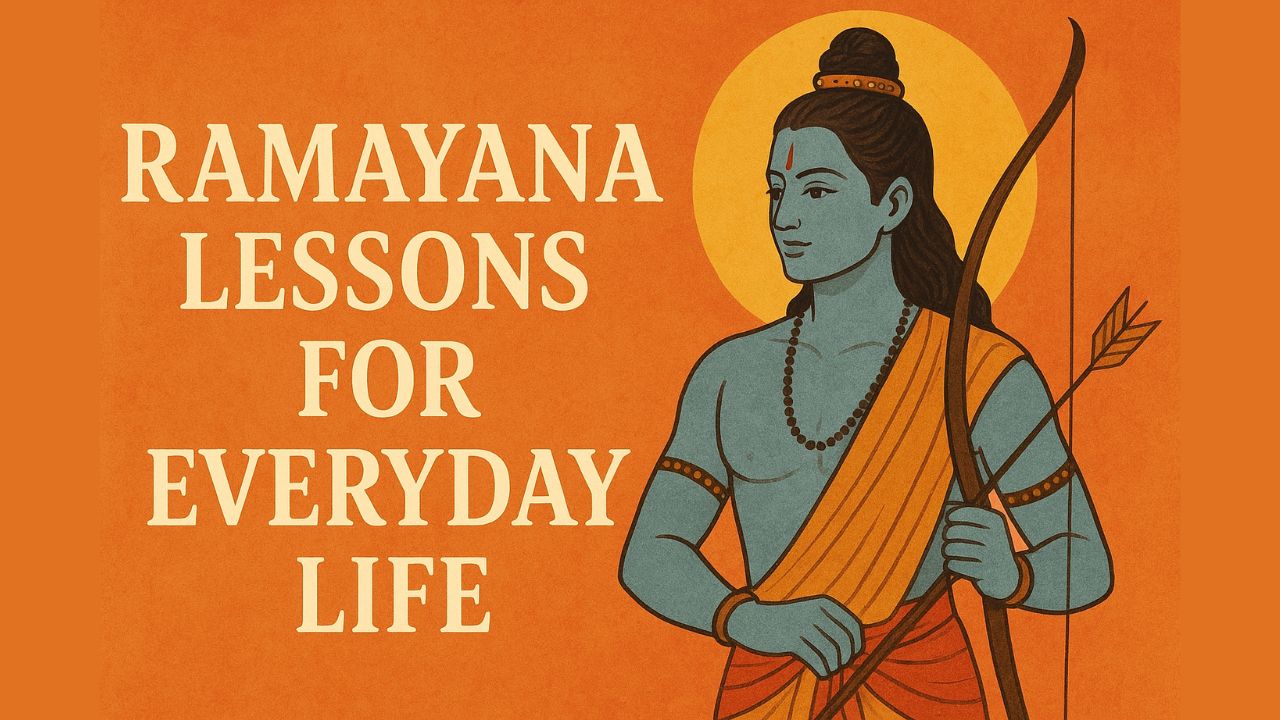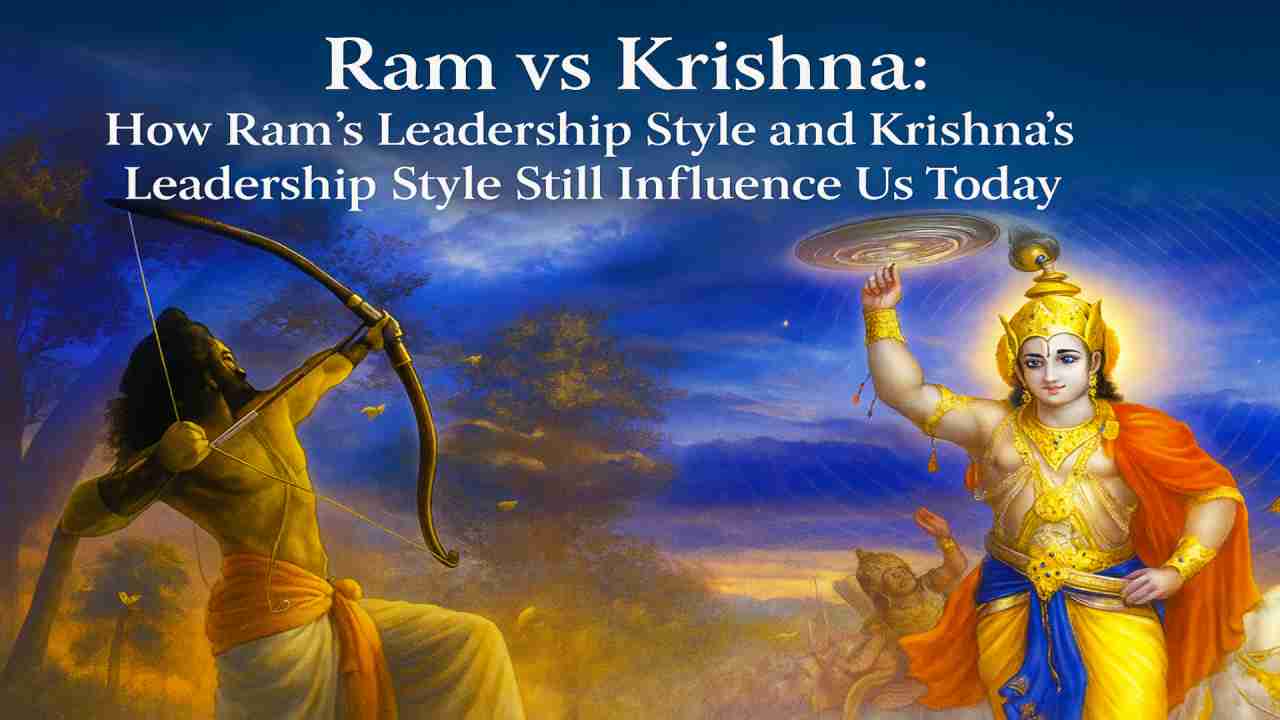
When talking about leadership in Hindu stories, the two names that stand out most are Ram and Krishna. Both are revered avatars of Lord Vishnu, and both played central roles in shaping dharma (righteousness) in their respective times. Yet, their approaches to leadership could not have been more different. The comparison of Ram vs Krishna is not just a theological discussion—it continues to influence how we think about leadership, morality, and duty in modern life.
Understanding Ram’s Leadership Style and Krishna’s Leadership Style provides profound lessons on integrity, pragmatism, and human psychology. Ram is seen as the leader who follows ideals and rules, while Krishna is the leader who relies on strategy, flexibility, and the situation. Together, they present two distinct but complementary archetypes of leadership that remain deeply relevant even today.
Ram’s Leadership Style: The Embodiment of Idealism
Ram’s Leadership Style is often described as “maryada purushottam”—the perfect man who upheld dharma above all else. His life, as narrated in the Ramayana, was defined by unwavering adherence to truth, duty, and moral order.
- Integrity Above All: Ram’s leadership rested on personal integrity. He chose exile for fourteen years rather than dishonor his father’s word. His decisions consistently placed dharma above personal comfort.
- Duty Before Desire: Even in moments of deep personal loss, Ram placed duty above emotions. His calm acceptance of hardships symbolized stoicism and discipline.
- Compassionate Authority: Ram led with compassion. He treated his allies, from Hanuman to Sugriva, with respect and empathy, winning their loyalty not by force but by fairness.
In many ways, Ram’s Leadership Style represents the “ethical framework” of leadership. It is the model where rules, discipline, and morality remain central. Leaders inspired by Ram are those who emphasize integrity, transparency, and justice, even if it comes at great personal cost.
Krishna’s Leadership Style: The Master of Strategy
While Ram stood for pure idealism, Krishna reflected practical wisdom. The Mahabharata paints Krishna as the divine strategist, philosopher, and guide whose actions often challenged conventional morality but always upheld a higher dharma.
- Situational Flexibility: Unlike Ram, Krishna rarely followed rigid rules. Instead, he adjusted his methods depending on the situation. For example, in the Mahabharata, he advised the Pandavas to use strategies like deception against enemies who themselves used unfair means.
- Practical Wisdom: Krishna’s leadership was not about personal sacrifice but about ensuring the survival of dharma in a complex, imperfect world. The Bhagavad Gita reflects his message of maintaining balance between doing one’s duty, staying devoted, and rising above attachment.
- Empowering Others: Krishna’s focus was never on ruling or claiming authority for himself; instead, he uplifted others, guiding them to realize their true potential. Krishna supported the Pandavas, leading Arjuna and his brothers toward their roles with wisdom and determination.
Krishna’s Leadership Style is often considered modern in its outlook. It emphasizes adaptability, people management, and the art of balancing ethical ideals with real-world challenges. Leaders inspired by Krishna are those who combine vision with tactical acumen, ensuring outcomes without being enslaved by rigid rules.
Ram vs Krishna: Contrasting Leadership Archetypes
The Ram vs Krishna comparison reveals two contrasting yet complementary leadership models:
Aspect | Ram’s Leadership Style | Krishna’s Leadership Style |
Core Principle | Integrity and adherence to dharma | Pragmatism and situational wisdom |
Approach to Duty | Duty above all, even personal suffering | Duty aligned with practical realities |
Leadership Nature | Idealistic, disciplined, rule-abiding | Strategic, flexible, results-oriented |
Impact | Inspires loyalty through righteousness | Inspires confidence through wisdom and adaptability |
Both approaches carry timeless value. In fact, when viewed together, Ram and Krishna embody a complete philosophy of leadership: Ram represents what leaders ought to be, while Krishna represents what leaders must do when ideals confront harsh realities.
Relevance of Ram’s Leadership Style Today
In today’s world of uncertainty and shifting values, Ram’s Leadership Style offers critical lessons:
- Integrity in Governance and Business: A leader like Ram reminds us that ethics must be the foundation of trust. Political leaders, CEOs, and administrators who stay true to their word gain credibility that cannot be bought.
- Leading by Example: Ram’s life illustrates that true leaders do not demand sacrifices they themselves cannot make. Such a trait becomes invaluable during moments of turmoil and uncertainty.
- Stability Through Discipline: In an age where impulsive decisions dominate, Ram’s calm, rule-based leadership provides a model for long-term stability.
Relevance of Krishna’s Leadership Style Today
At the same time, the modern world often demands Krishna’s Leadership Style—dynamic, adaptive, and rooted in realpolitik.
- Strategic Decision-Making: Whether in politics, military strategy, or corporate competition, Krishna’s ability to think several steps ahead remains a model for effective leadership.
- Guidance and Mentorship: Just as Krishna guided Arjuna in the Bhagavad Gita, today’s leaders must act as mentors, empowering teams to realize their potential.
- Balancing Ethics with Practicality: Krishna teaches that rigid morality can sometimes fail in a flawed world. Leaders must adapt while still protecting the larger good.
Ram vs Krishna: A Combined Leadership Blueprint
The debate of Ram vs Krishna is not about choosing one over the other. Instead, it is about understanding how both models can work together.
- From Ram, we learn integrity, truth, and moral courage.
- From Krishna, we learn strategy, adaptability, and situational intelligence.
A leader who embodies both Ram’s Leadership Style and Krishna’s Leadership Style becomes complete—principled yet flexible, ethical yet pragmatic. This synthesis is the need of the modern world, where leaders must navigate both values and realities.
Spiritual Lessons Beyond Leadership
Beyond politics, business, or management, the Ram vs Krishna dialogue influences our personal lives as well.
- In personal bonds, Ram sets an example of loyalty and trustworthiness, whereas Krishna shows the importance of flexibility guided by compassion.
- In challenges, Ram guides us to face hardship with dignity, while Krishna reminds us to use wisdom to overcome obstacles.
- In spirituality, Ram’s path reflects devotion through discipline, while Krishna’s path emphasizes devotion through love and surrender.
Thus, Ram and Krishna are not just mythological figures but enduring archetypes who shape how we live, work, and lead.
Final Thoughts: Why Ram vs Krishna Still Matters
The timeless comparison of Ram vs Krishna is not merely about mythology—it is about leadership, values, and human behavior across ages. Ram’s Leadership Style continues to inspire leaders who value discipline, morality, and justice. Krishna’s Leadership Style, on the other hand, resonates with those who value strategy, adaptability, and guidance.
Together, they form the two pillars of effective leadership—idealism and pragmatism. As we face the complexities of modern life, the choice is not between Ram or Krishna. The real wisdom lies in learning when to lead like Ram and when to lead like Krishna.
Both paths, when balanced, create leaders who can uphold dharma in any era. That is why the legacies of Ram and Krishna continue to guide us—not as distant mythological heroes, but as eternal teachers of leadership and life.


